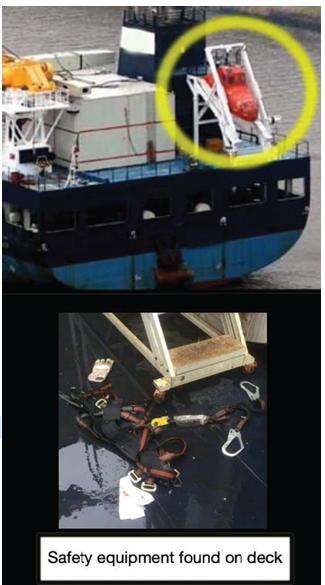202350 - Lifeboat self-launches causing two fatalities
The free-fall lifeboat launching system on board a general cargo vessel underwent a substantial onboard service by a manufacturer certified service company.
As edited from Antigua and Barbuda report published November 2016
As the lifeboat needed a replacement release cable, among other things, the release system had to be reset and secured. This was done as per specifications and confirmed by the attending class surveyor.
The morning after the servicing and before departure, the safety officer found that the lifeboat release pin at the hook position (aft top of the boat) could not be moved. This was not as expected, and he discussed the matter with the Master and the vessel’s bosun, who agreed to look into the problem during the day.
Once underway, the issue of the stuck pin was discussed on bridge with the Master and the safety officer. The bosun, an experienced mariner and regular on the vessel, was tasked to prepare the required risk assessment and permit to work, which was apparently done in accordance with the procedures set out in the vessel’s Safety Management Manual. Shortly after lunch, the bosun reported to the safety officer, who was OOW at the time. He informed the officer that he and another deck crew were proceeding to the vessel’s stern to commence work on the safety pin.
Some 45 minutes after the bosun’s call, the OOW noticed a lifeboat in the water astern of the vessel. He immediately called the bosun via VHF radio but received no response. The Master was informed. At the same time, another crewmember reported by VHF radio that the bosun was lying on the aft deck and that the lifeboat was missing, as was the second crewmember.
Emergency procedures were instigated but the missing crewmember could not be located. The bosun was found to have very shallow breathing and was prepared for emergency evacuation by Search and Rescue (SAR) helicopter. He was later declared deceased.
After further searches, the missing crewmember could not be found and was presumed to have fallen overboard. Search and Rescue units were activated, and search continued until darkness, without success. The lost lifeboat was retrieved and brought to shore for inspection. After close examination of the release gear and condition of the boat, it was reinstalled on board the vessel as it was undamaged.
Since the only persons on scene were the victims of the accident, and both tragically lost their lives, no information or details on how the work was conducted and how the situation evolved at the lifeboat could be assessed. The positions of the crew members could not be determined, nor the sequence of events elaborated. The launching arrangement showed no signs of failure or damage. The release of the free fall lifeboat seemed to have taken place as normal, but it was clear that the lifeboat maintenance securing and/or simulated launch device had not been connected at the time of the unintended release.
The lifeboat’s release device at the helmsman’s chair was found untouched and in a closed position. The safety officer’s findings of a stuck hook safety pin prior to departure suggest that the hook might have been already in a ‘released’ state when the crew began their work. The lifeboat manufacturer’s user’s manual states ‘If release hook safety pin cannot be removed off the hook casing without excessive force, the hook might be released. Secure boat release hook and check system.’
The working hypothesis of the investigation is that the service company technician did not properly reset the release mechanism in the closed position. When the crew tried to free the safety pin the hook released fully, allowing the boat to launch in free fall to the sea. The bosun probably fell to the deck while the other crewmember fell overboard and drowned.
The safety officer had initiated the task and verbally instructed the crew members but had not checked the situation at the boat deck during the work as he was still on OOW duties.

Lessons learned
- Adherence to the on board safety procedures and other instructions available such as the manufacturer’s information manual is a prerequisite for safe operations.
- A toolbox meeting and verbal preparation and instructions are best done at the work location to allow better understanding of the situation and a discussion of the hazards and mitigating strategies.
- Proper supervision is a key element for safer operations.
